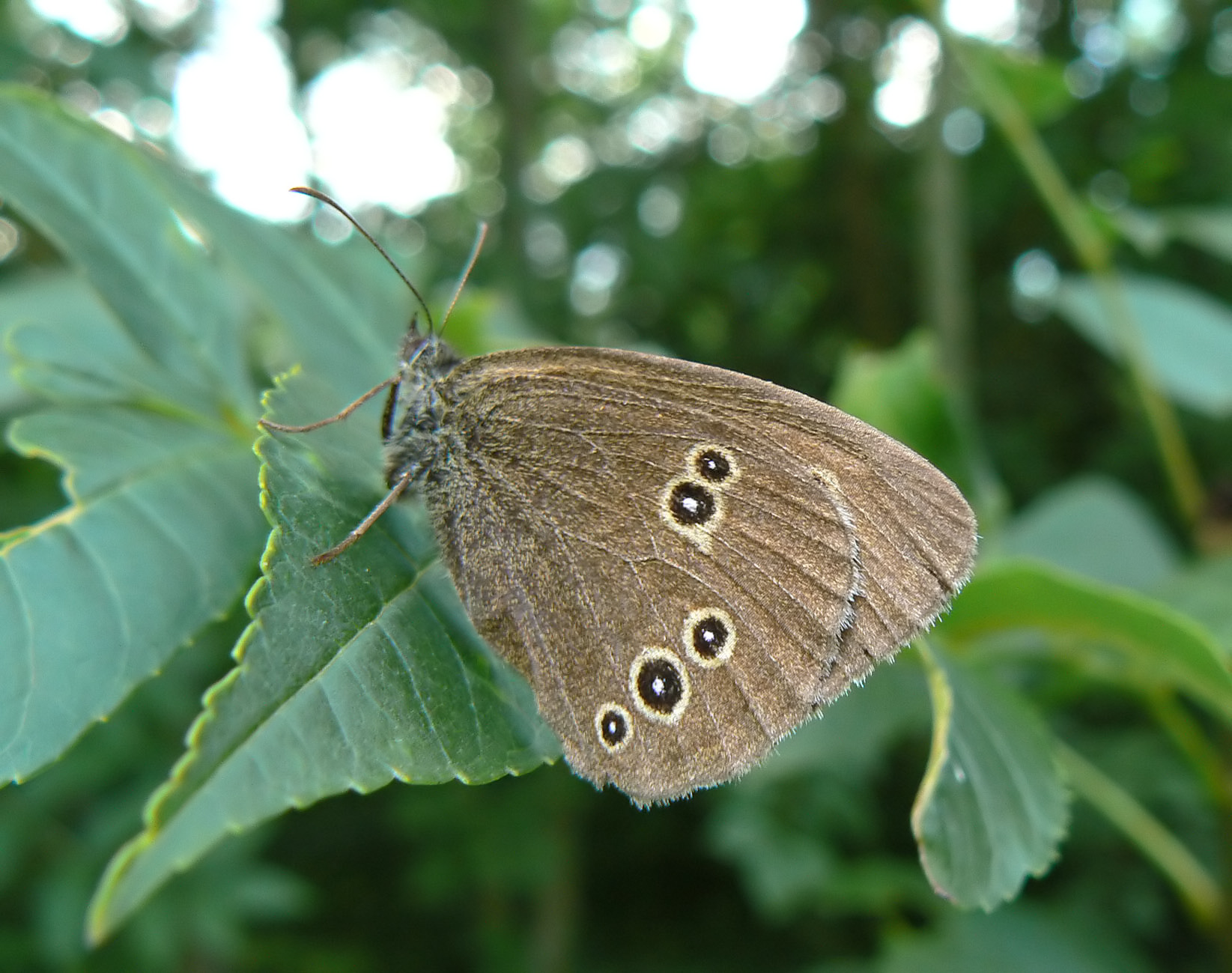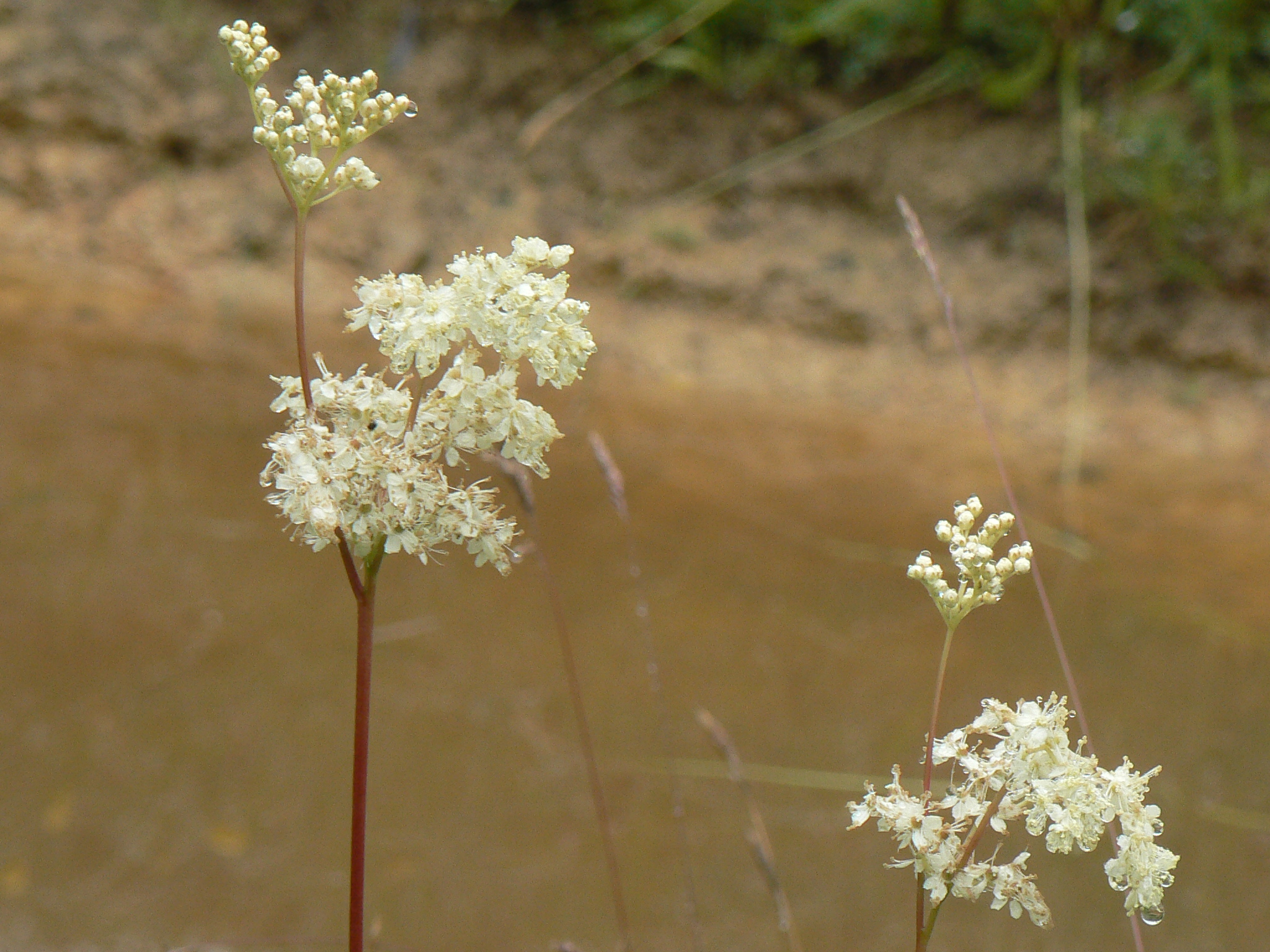Tuesday 25th September - Ray Baker
I was doing a walk around the wider area today and came back via the reserve at about 10am. Not a great deal to be seen - but the following were noteworthy sightings:- Magpies were out in force hunting for insects in the newly-mown meadows - I counted a group of 12 and, even though they do tend to group up in the autumn, this was still quite a few to see in one place - I don't think the rhyme 'One for sorrow, two for joy' etc goes up as far as 12!! There were a couple of Jays around too - they are at their most visible at this time of year, as they fly back and forth with acorns for their winter stash - but I imagine that they are in for a tough time this year, as acorns seem to be very thin on the ground.
Best bird though was a Green Woodpecker prospecting (for ants probably) in the short grass just by Coldharbour Copse. It is far more usual to hear these birds rather than see them, as they are quite shy of human disturbance and will often flush very easily, and also they are not always easy to see on the ground - they do favour quite short grass, but not so short that they can't succeed in hiding most of themselves away from a casual observer, often just leaving their head and red crest to give away their position. A dog-walker stopped and was asking about the birds, and I couldn't succeed in making him see this one, despite lending him my BINs!
I never did manage to get any concrete evidence that the Green Woodpeckers were breeding in the reserve, but I did see and hear them quite a bit in the Spring time, and have been hearing them again quite consistently these last few weeks, so there is a chance that they did, but I could never get that definite proof that they were.
Small birds were pretty much absent, although I did hear a Chiffchaff.
I had a look around the pond, and for just about the first time since the early spring, failed to see any newts or larvae at all. Maybe they have all finally hauled up onto dry land now that the weather has started to turn a bit more autumnal.
Talking of Magpies, I thought that I would attach the following photo..... So next time that you're thinking 'Not too happy about the way I have to make a living.', think of this Magpie!!
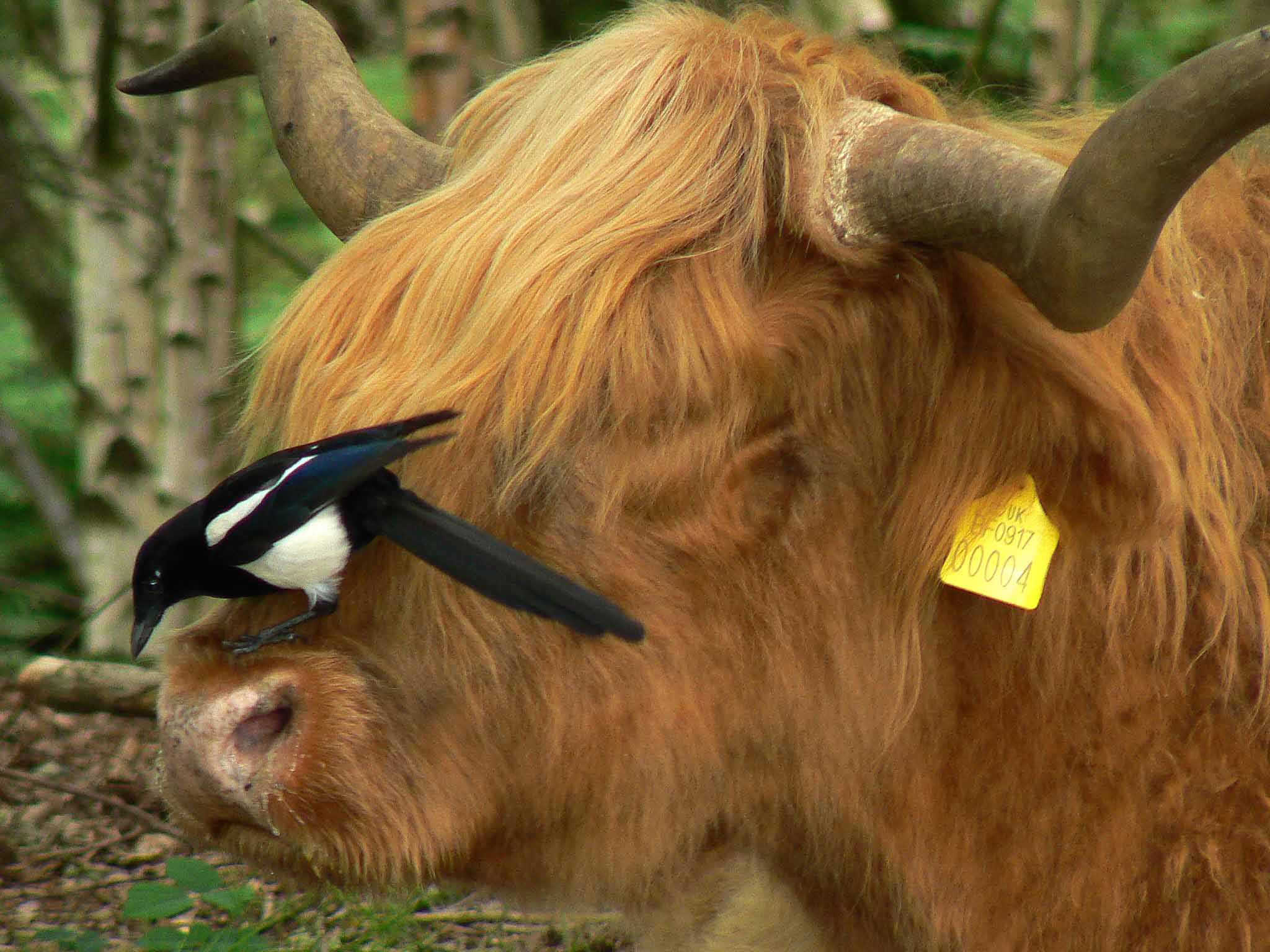
Sunday 16th September - Ray Baker
We carried out our final pond-dipping session of 2012 today - which was surprisingly well-attended and also yielded a surprisingly good catch! There are some more details in 'Latest News', and details of the full catch in the 'Surveys' page.
I have been trying to get to grips with identifying dragonfly larvae and have reached the stage where I can split them into certain groups, but to be absolutely sure of being able to nail the ids at species level, I have come to the conclusion that you need to catch pristine individuals and be able to examine them at leisure under quite high magnification - so not really possible during a pond-dipping session. I will persevere, but at the moment, that is as good as it gets.....
Anyway - here are a couple of examples of dragonfly larvae that were caught today, and compared to what an adult might look like.... This was a fascinating comparison for many - that something so ugly could grow into something so handsome.
The first pair are Chasers/Darters. Unfortunately I lack the skill to tell them apart with complete confidence, but I rather fancy that these are Broad-bodied Chaser larvae, so that is the adult that I have shown!
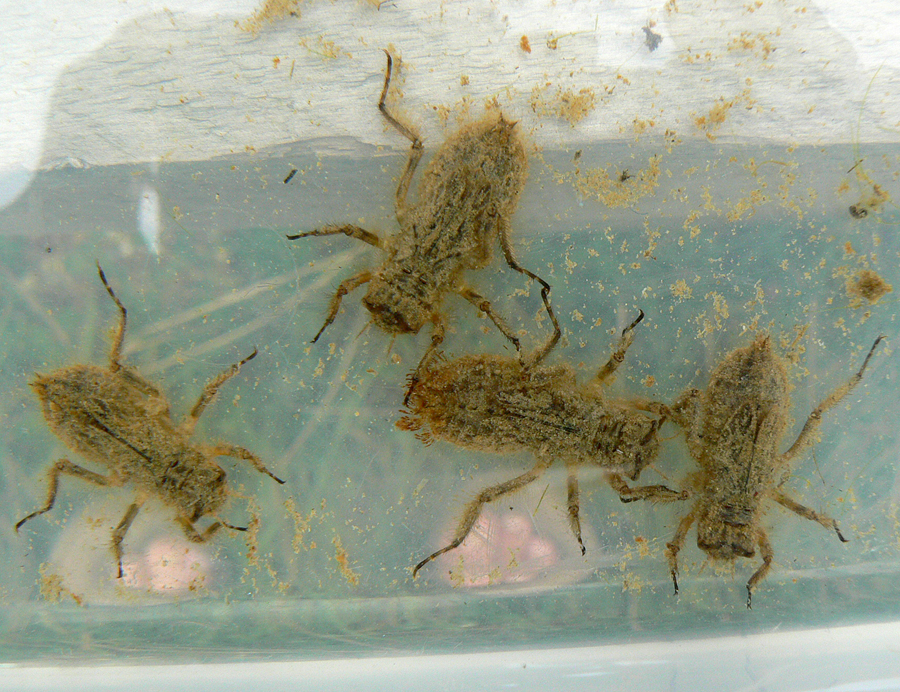
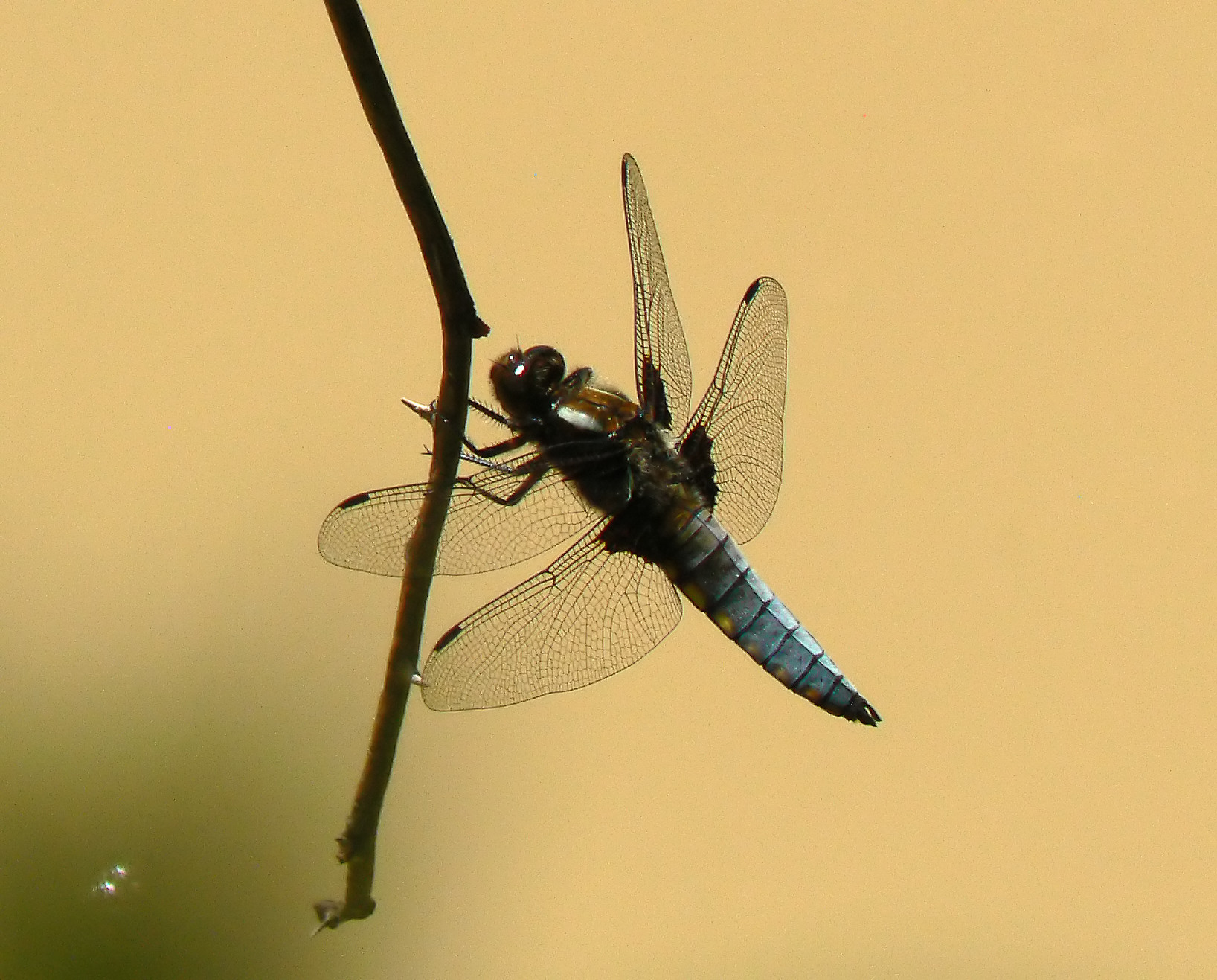
This next pair are Hawkers. I am pretty sure that the larva is either a Southern or Brown Hawker but can't tell them apart! We had an adult Southern Hawker 'helping' us with the pond-dipping today, so for that reason alone, I'll assume it to be one of those!
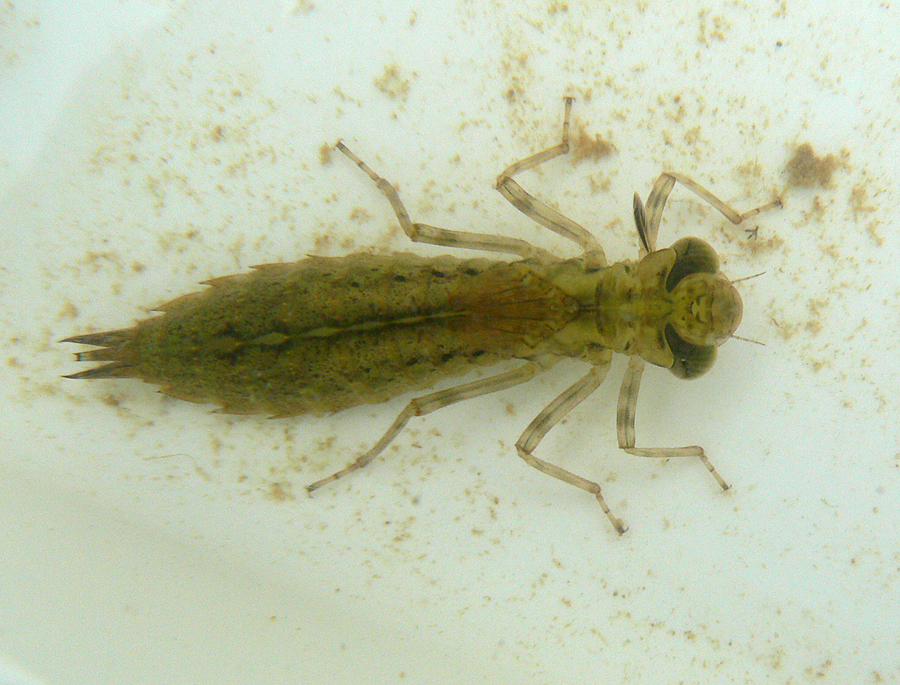
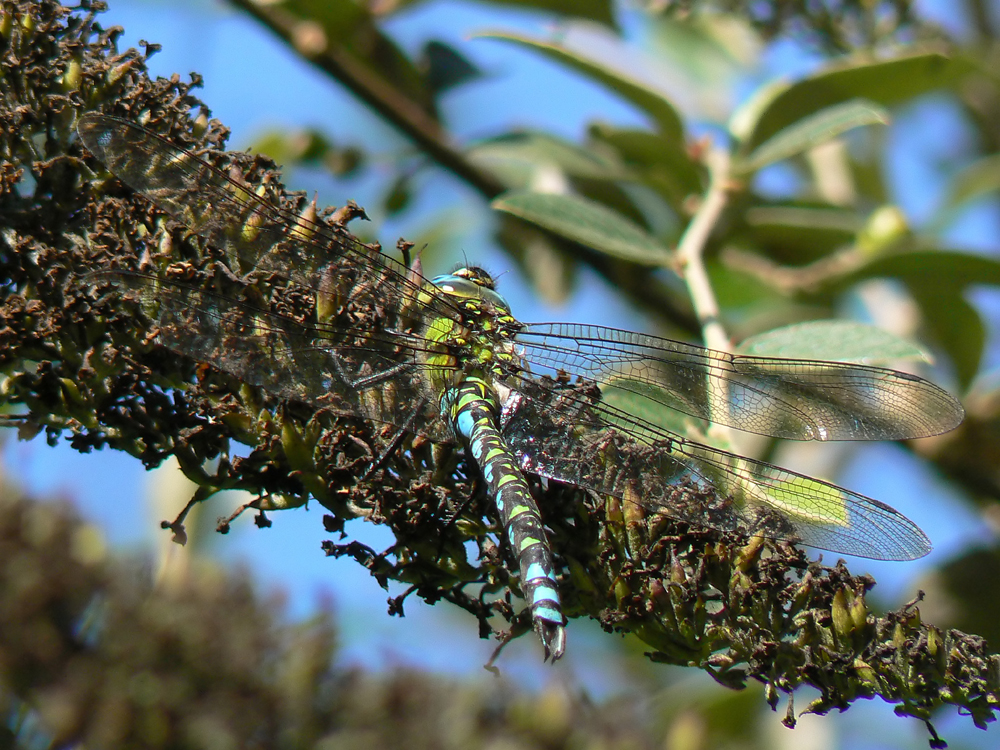
Sunday 9th September - Ray Baker
I haven't had a chance to go around the reserve much these last few days, but have got a few minutes to clear up a couple of points that I mentioned earlier...
I did have some Small Tortoiseshells in my garden - initially 2, but by Tuesday this had grown to 4, and they stayed all week, but for some reason there are none to be seen this morning. Judging by the fact that they all arrived at the same time, and were in pristine condition, I'm thinking that they are all newly hatched from a brood of caterpillars somewhere in the immediate local area. The plant in question is nettles, and we have many patches around - in mine and neighbouring gardens, down the twitten at the reserve boundary, as well as on the reserve itself, and I haven't been able to find any more caterpillars, so I don't know exactly where they came from. It is a very good sighting though - as far as I know, we haven't had any of this species in the reserve in either 2011 or 2012 to date.
It has actually been a very good week for butterflies in my garden, with 11 species being noted: Comma, Red Admiral, Peacock, Small Tortoiseshell, Small White, Large White, Brimstone, Common Blue, Small Heath, Speckled Wood and Small Copper!
I also mentioned about Southern Hawker dragonflies laying their eggs on dry land..... They do! The way that it works is that the eggs are laid in dead wood and plant material in the general vicinity, and after hatching, the prolarva makes its way into the water via a series of 'prodigious leaps', after which normal larval development continues in the pond.
Monday 3rd September - Ray Baker
It can be quite handy living so close to the reserve, as I can use activity in my own garden as a kind of 'barometer' for what might be going on over at the reserve, and plan my visits accordingly. I had been struck by the number and variety of butterflies in my garden this afternoon - not only the usual crop of Large and Small Whites, but also a Peacock, Red Admiral, a couple of Meadow Browns and, best of all, 2 Small Tortoiseshells on Sedum, which was just coming into flower. This latter species were a very good sighting - the first I personally have seen in 2012 and very thin on the ground out in the wider countryside, so I thought I would go and check the butterfly garden, as Sally and I had planted quite a few Sedum plants earlier in the year,
In the event, I needn't have bothered as there were no butterflies to be seen (a couple of teenagers playing silly-beggars in the undergrowth probably didn't help!) and only a single Peacock on the buddleia.
I walked around the rest of the reserve.... There were the usual crop of Common Darters around the pond (wouldn't be surprised if we have 10+ there) and I also saw a Banded Demoiselle and the female Southern Hawker was there ovipositing again. The first time I saw this, it was laying eggs on the vegetation at the waters-edge (which I assumed was a bit of a mistake in its part!) but I believe it to be the case that this species actually lays it eggs on dry land - I will do a bit of reading and try to find out how this works - but today at any rate, it was trying to lay its eggs on the pond-dipping platform!
As I walked back I saw what I believe to be 2 Migrant Hawkers - one by the copse of Aspens by the pond and the 2nd in the Wildflower meadow. These are quite frustrating to try to observe, as they seem to spend nearly all of their time just patrolling backwards and forwards, catching smaller flies etc, and presumably on the look-out for females. I have submitted my photographs from the other day to the British Dragonfly Society just to confirm my ids, but I'm reasonably confident that I have the hang of it!
As I was walking back, I bumped into a neighbour, who was telling me that he had a Sparrowhawk in his garden the other week.... After a bit of a barren spell, that is several sightings over the last few weeks, plus I have been seeing a pair of Coal Tits on my feeder, which again had been absent for some time - here's hoping that the 2 species don't bump into each other!!
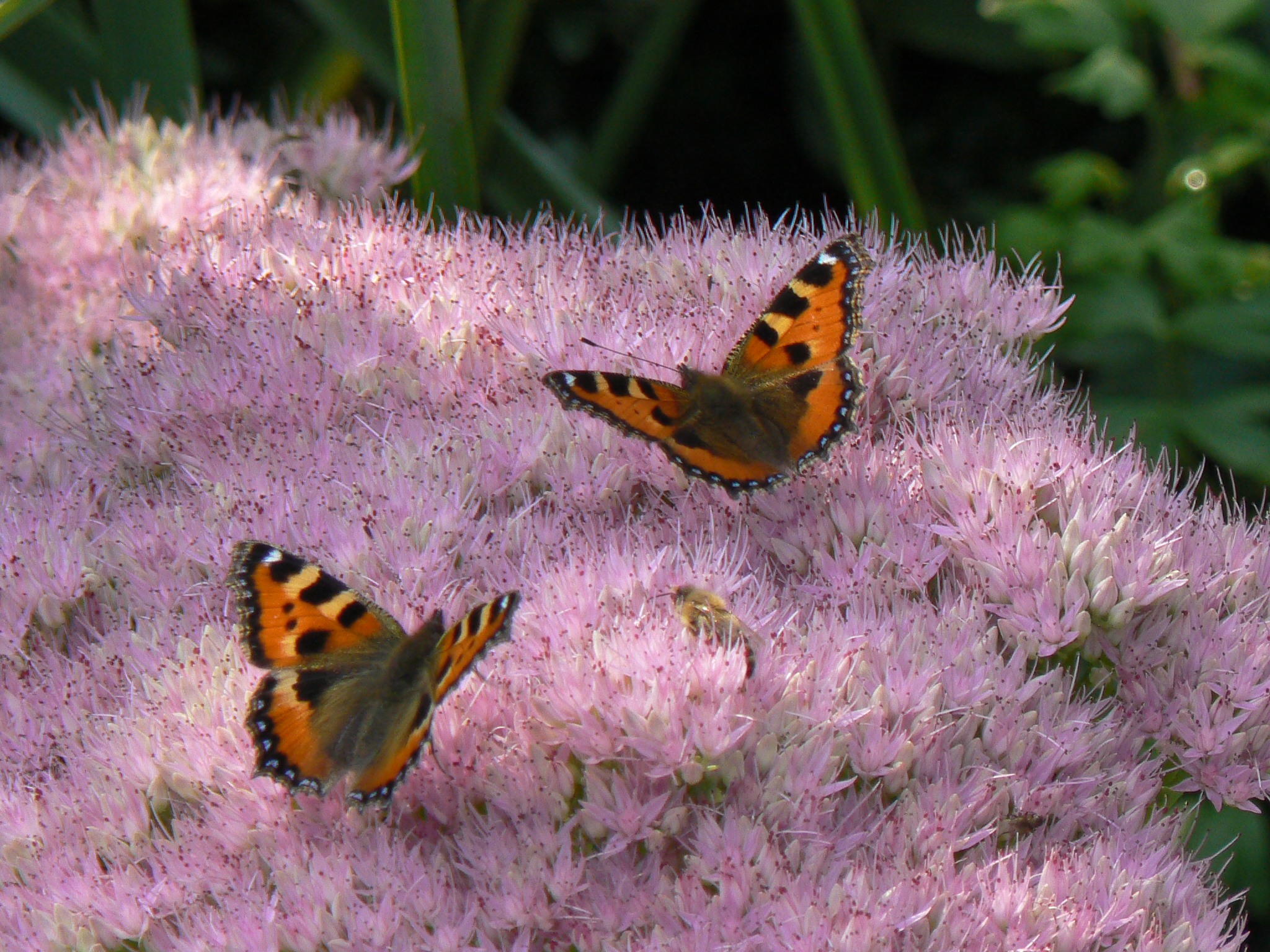
Friday 31st August - Ray Baker
I was pleased to be able to get to the bottom of the mystery surrounding whether I had seen a Southern Hawker or Migrant Hawker dragonfly earlier this week - and the answer turned out to be 'both'! I started off down at the pond, clearing up the detritus from our pond-clearance work of the other day, and I saw a female Southern Hawker again (quite likely to be the same individual as earlier in the week I would imagine) and a blue male dragonfly paid a fleeting visit but pushed off before I could get a decent look at it. I was resigned to another day of not getting an id of this pesky male, when I saw a large dragonfly zooming around in the butterfly garden, and with a bit of perseverance, was able to track it down to its perch on one of the trees and get some photographs. Looking at my field guide, I am pretty certain that the broad green bands on the thorax make this a male Southern Hawker.
I was patting myself on the back as I walked through the orchard when I saw another dragonfly - this one appearing a bit smaller and darker - so pretty sure that it wasn't either a Brown or Southern Hawker, but probably too big to be much else.... Again, I was able to track it down and get some photographs and I believe it to be a male Migrant Hawker!
Neither of these 2 Hawker species had been recorded on the reserve before (although this probably owes more to lack of expertise and surveying on our part than any particular rarity - they are both quite common species) and it is good that our 'dragonfly list' for the reserve continue to grow, with 4 new species being added this summer.
I have also been very pleased to regularly hear House Martins zooming about above me, as I have been around the reserve in recent weeks. This species is not doing at all well in the area, mainly due to lack of nesting opportunities in modern houses (these are the birds that build small cup-shaped nests under the eaves). Interestingly enough, I did a walk between Canary Wharf and London Bridge a while back, and there are loads of House Martins up there - they find the underneath of the balconies of the yuppie-flats in docklands very much to their liking! It's any ill-wind, as they say
Male Migrant Hawker (narrow yellow bands on thorax) Male Southern Hawker (broad green bands)
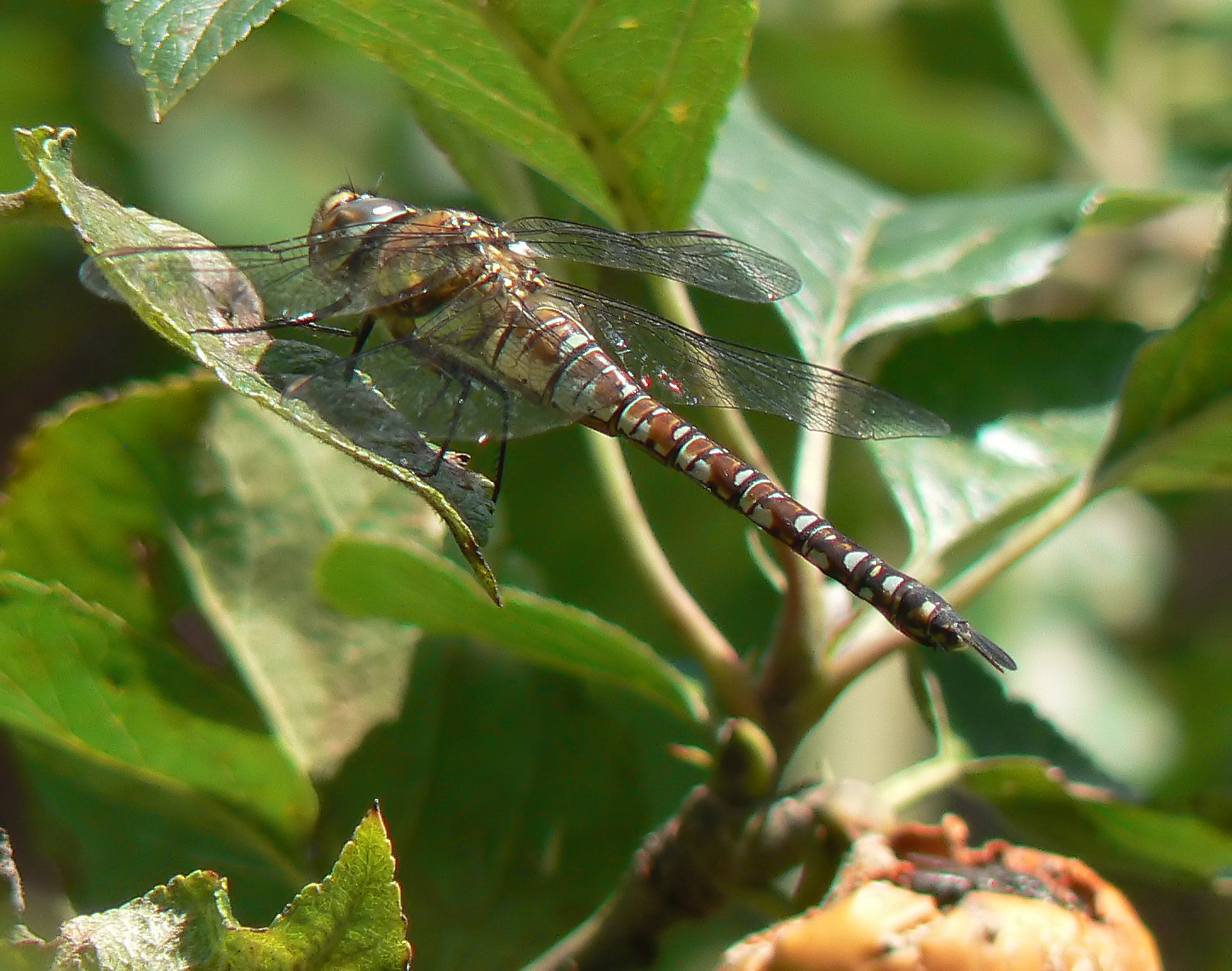

Tuesday/Wed 28th-29th August - Ray Baker
Some of us were down working in the pond area on Tuesday, and we saw some interesting things - mainly dragonflies. I have been seeing the large and impressive Brown Hawkers around the reserve quite consistently now and today was no different, with a male and ovipositing female being seen around the pond and another male in the butterfly garden. On Tuesday, there was also another medium/large greenish-blue dragonfly which patrolled the pond for some minutes, but didn't settle. I did get a reasonable view through my BINs, and thought it likely to be either a Southern or Migrant Hawker, but unfortunately couldn't remember how to tell them apart - this is what prompted me to return during a sunny interlude on Wed for another look!
We were also struck by the number of Common Darters which were buzzing around us - they are often quite tame and will settle on the wooden platforms and bridge..... I don't know how many were there in total but I did see 5 in one small area all together, but I suspect rather more than that. We also saw a single Banded Demoiselle, which was good, as they are not often seen on the reserve.
We also saw a rather intriguing spider... Looked at from above it appeared yellowish, but close inspection showed it to have yellow and cream stripes, but dark brown and yellow stripes made it look quite wasp-like if viewed from underneath. Just to complete the intrigue, if left alone, it would stick most of its (very long!) frontal legs out in one narrow group, so that it took on a kind of squid-like appearance. I have been doing a bit of detective work and I believe it to be tetragnatha extensa, which is a member of the aptly named group of Stretch Spiders!
As mentioned, I went back on the Wed, in the hope of seeing the patrolling male dragonfly. Of course, it wasn't to be seen, but what WAS there was an ovipositing female, which I am 99% certain is a Southern Hawker. Of course, this doesn't necessarily mean that the male of the previous day was the same species, but chances are it was....
In non-dragonfly news, there was a female Common Blue butterfly buzzing around the bridge (just to confuse matters, female Common Blues are actually brown!) and my attention was drawn to a kerfuffle going on in the hedge behind me, the reasons for which became clear when a male Sparrowhawk emerged with a small bird struggling in its talons. I didn't really get a good look but thought it most likely to be one of the many House Sparrows that live around the pond. I hope it wasn't a Bullfinch, which have just started to eat the berries around the pond area - there are rather fewer of them!
Southern Hawker Stretch Spider
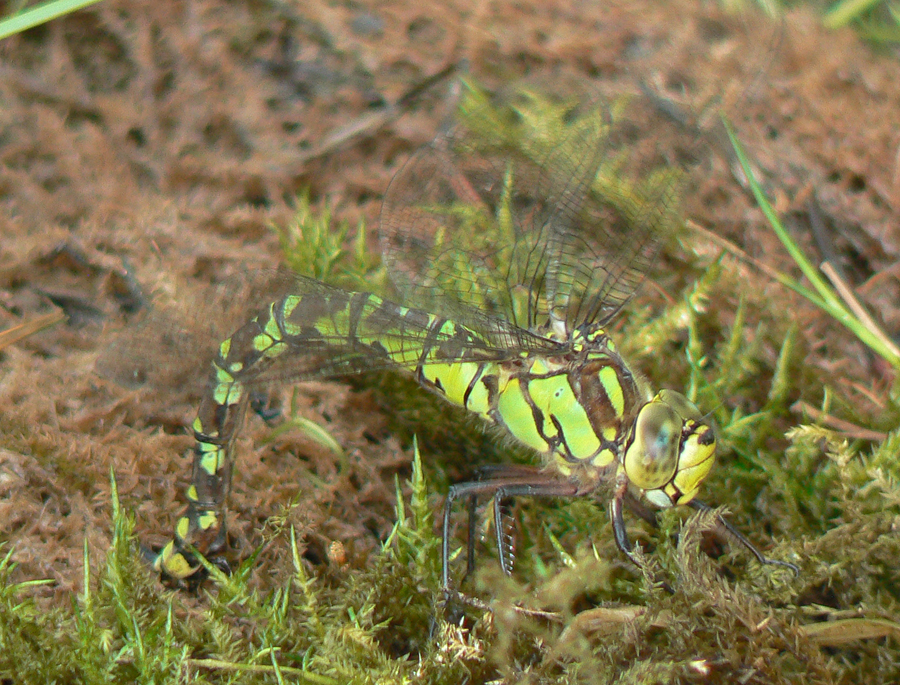
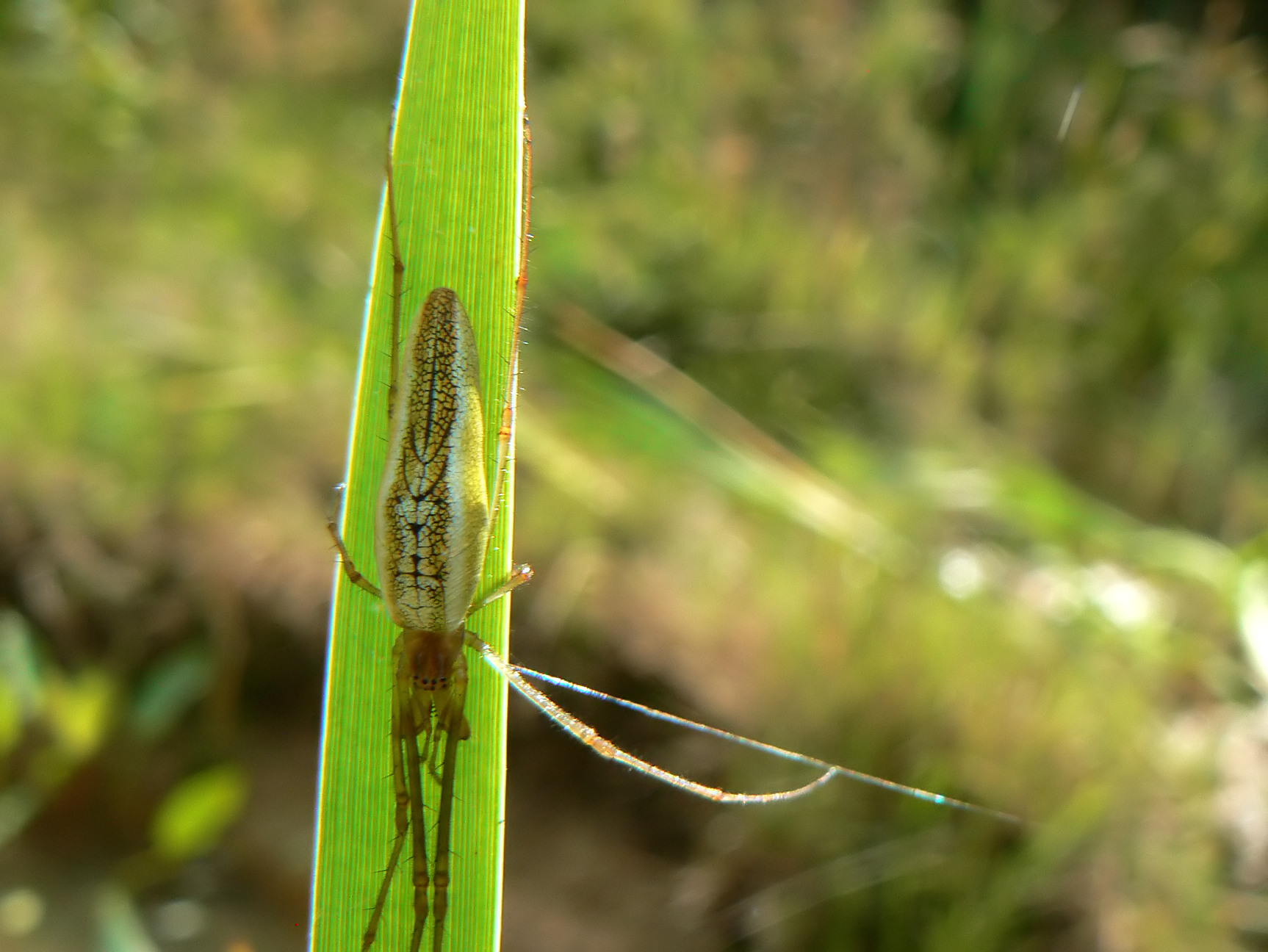
Tuesday 21st August - John Madden
Sometimes you see familiar things behaving in an unfamiliar way. Today was like that. I was looking at the ponds and again saw lots of insects on one particular tree (I first noticed this over the weekend). The tree is a goat willow which was shading the smaller pond so I cut it back severely earlier in the Summer. It has grown back strongly so the shoots are already well over a metre long. It was covered in wasps who were exploring the leaves. Nearly every part of the tree had wasps all over it. Not only were there wasps but also hover flies and other insects. This evening some of the lower leaves were literally black with small fly like insects. The only explanation I can think of is may be the leaves are covered in honey dew or some similar attractive secretion. However, I could not see any aphids to account for the honey dew. Strange.
Sunday 13th August - Pond Dipping - Ray Baker
It was quite an interesting and well-attended public pond-dipping session today, and as usual, we all learnt a fair bit! This is one of the advantages of not being too experienced about pond-life - you can very easily increase your knowledge.
It is proving instructive to watch how the 'catch' changes as the season progresses - it is very noticable that we are now catching less insect larvae than we did a few months ago, which is probably to be expected as many creatures achieve the transformation to their adult stage and often will leave the water altogether. We have noticed fewer damselfly larvae and other flying insects, and we only found a single adult newt this time - they have obviously all now left the water, getting ready to spend the rest of their lives on land until the breeding season starts again next year - they seem to return to the water around March, although I guess that this is weather-dependent.
Another thing that we learnt this session was that Water Boatman can fly! They obviously didn't think very much of being confined in our inspection trays and had no problem at all flying the 3-4m back to the pond. Remarkably, none of us had ever seen this before.
We also caught a couple of previously unseen species - a Great Diving Beetle and an Alderfly larva. I imagine that we will continue to find new things until such times as we have run quite a few more dipping sessions and also increased our own knowledge.
It was good to be able to show the children (and some adults!) some mature dragonflies that were present around the ponds today, and to be able to explain that the rather ugly larvae that we had in our trays would one day turn into the beautiful adults. We had Azure Damselflies, Common Darter and also a large brown and blue dragonfly which we have tentatively id-ed as a Brown Hawker, although it did seem to have rather a lot of blue on it, and sadly it would never settle to enable us to take some photographs which probably would have settled the matter.
Even though the pond water-level has dropped by 25cm or so over the last few weeks, there is still plenty there, so fingers crossed that we will be able to offer a dipping-session in mid-September - it will be interesting to see what we can pull out that day!
Alderfly larva Great Diving Beetle
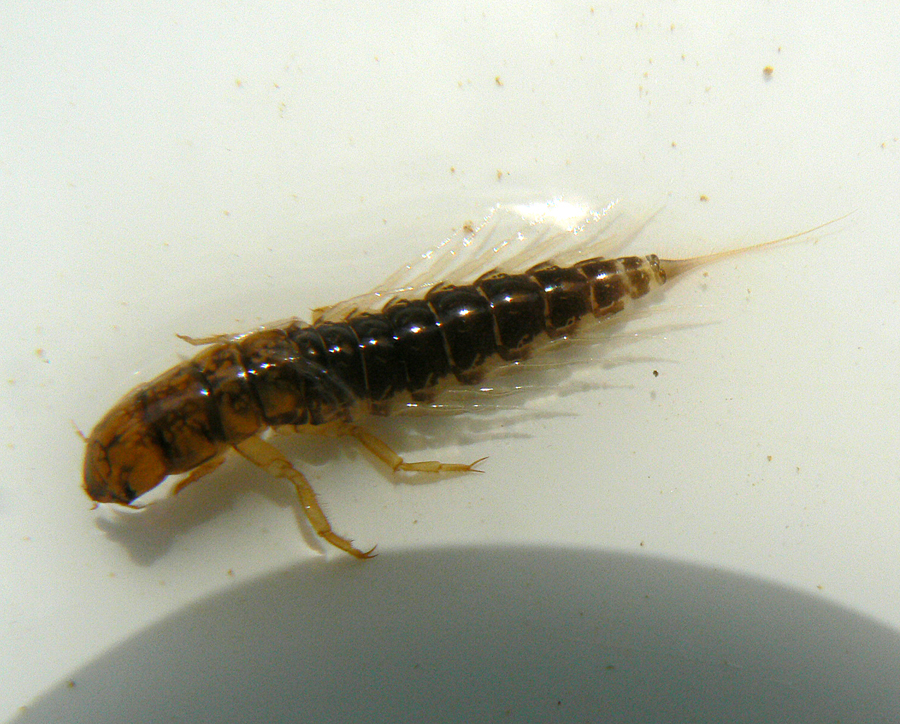
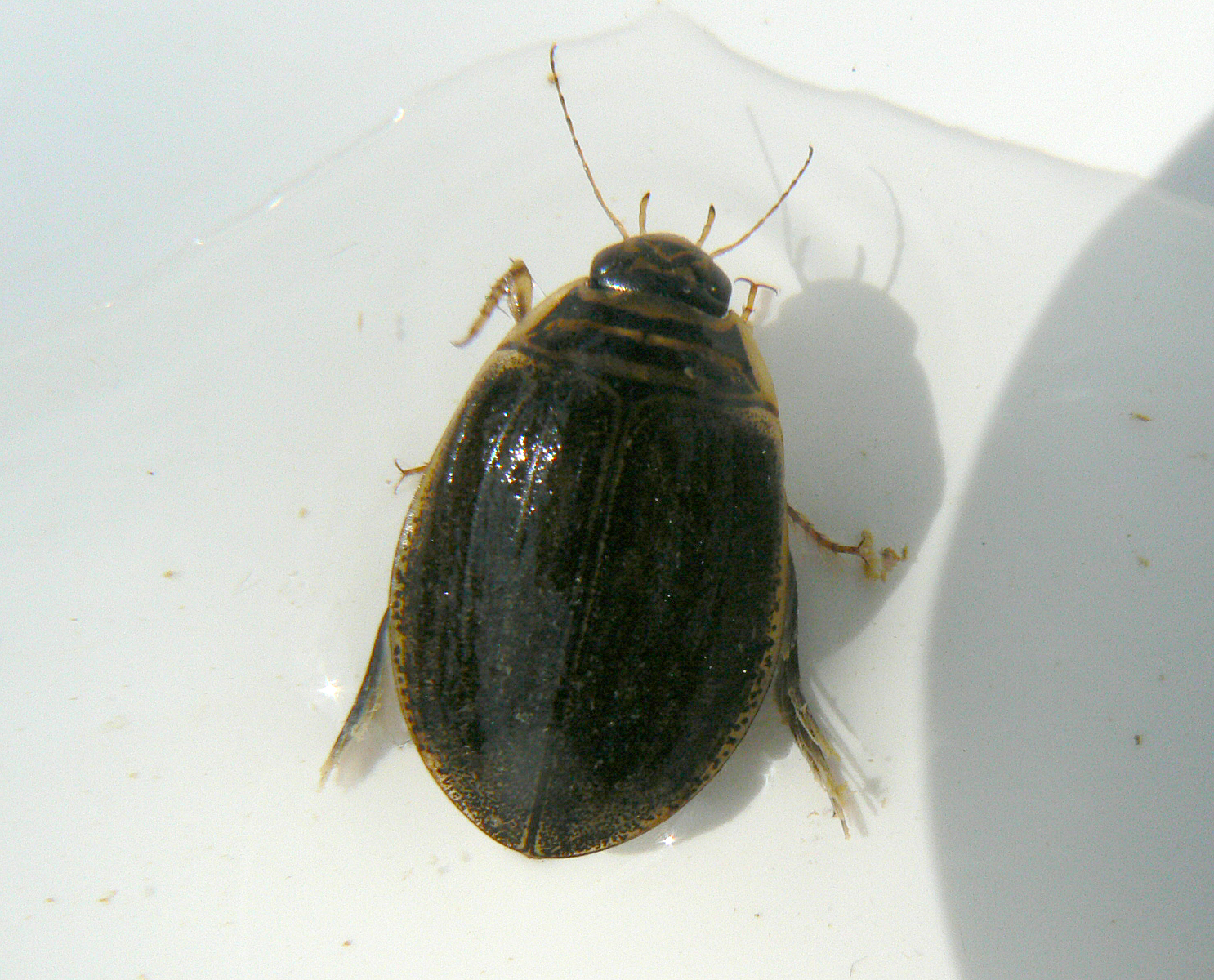
Monday 6th August - Ray Baker
I am currently hors de combat, which is a shame, as the sighting of a Brown Hairstreak is very exciting and I would very much like to go and investigate! ...What I can do though, is tell you a bit more about the species.
They are present in the general area but are very rare, although (like many hairstreaks!) are extremely difficult to find and identify, and so there are perhaps rather more of them around than you might think.
They live in colonies and, like some other species of butterfly, they favour a 'master tree' which is usually a mature Ash, around which the males tend to congregate. They spend most of their time basking on the outer leaves, and only occasionally take off for a little fly-around to do battle with other males, and to attract females (which is when they are easiest to see) and even more occasionally, come down towards ground level to feed. In my own experience, the males tend to fly earlier (around 2nd-3rd week of Aug, John's sighting was quite early) and then the females become noticable more towards the end of the month, when they will repeatedly leave the 'master tree' and head off to lay their eggs on mature Blackthorn.
I suppose that there might be a couple of scenarios for us: one of the mature Ash trees around the quiet garden may have become a 'master tree' for a new colony of Brown Hairstreaks - this would obviously be fantastic news, or maybe John just saw a lone individual that was passing through.... I don't know enough about BHs to know which is more likely, but I do know that, once a colony has been established, they are usually very reliable and will be seen on the same tree for year after year.
Fingers crossed that we have a colony in the making, so eyes peeled for the next couple of weeks to look for small, dark butterflies up in the higher branches.
They are quite difficult to photograph, so I only have the one.... It's of a female - which are quite like males, but the orange patches are much bigger in the female and can clearly be seen in flight - the males appear to be much darker.
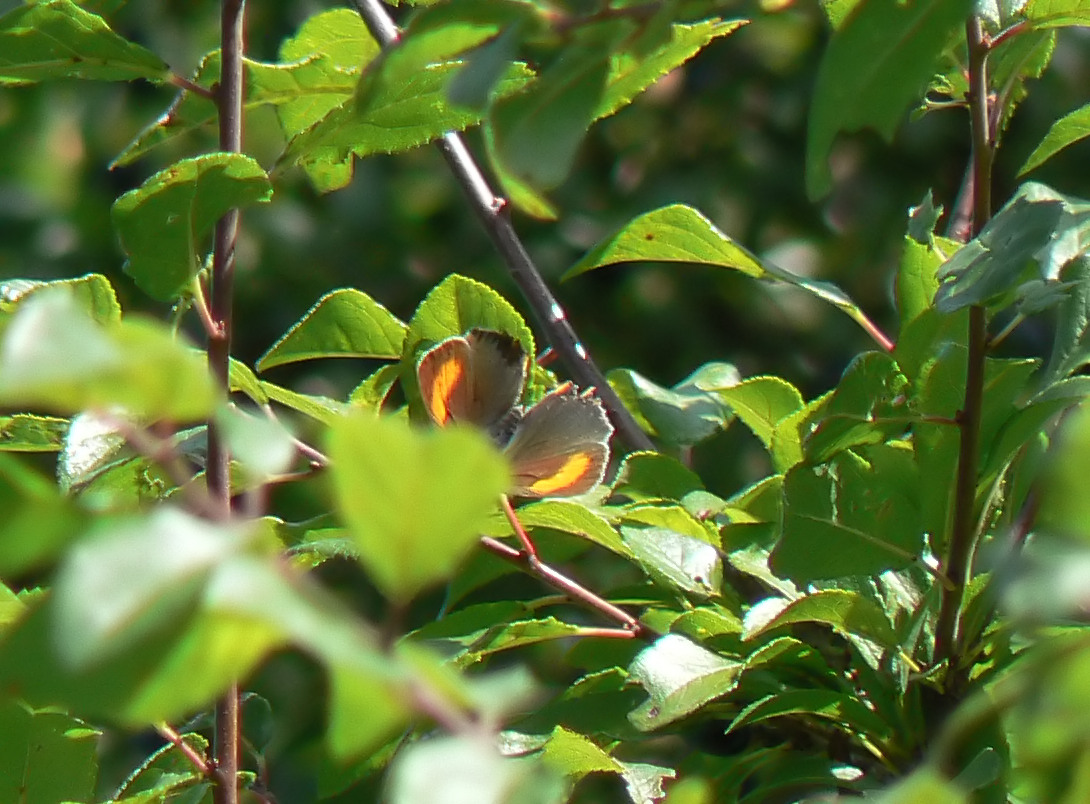
Sunday 5th August - John Madden
This year is supposed to be very bad for butterflies so the last thing I was expecting today was a personal first sighting of a new species and a new record for the reserves. I was walking through the quiet garden about to complete my weekly butterfly transect count when I spotted a butterfly nectaring on hogweed in the sunshine next to the path. I initially thought it was another gatekeeper which are common on the reserve at the moment. It sat on the flower head, wings closed, showing an orangy brown underwing with a pattern of thin white lines across it. Realising it was nothing I had seen before I sketched it noting the the tiny orange and black tails at the base of the hind wing. As a consequence of my encouragement to fly so I could see its upper wings, it took off and landed on my face! I returned it to the flowers where it carried on feeding but I had seen that the upper wings were a very dark brown. It was still on the same flower when I set off to complete my count and showed non of the restless flitting from flower to flower that you would expect from a butterfly and was the case with the gate keepers and meadow browns present in the quiet garden.
Reference to the "Butterflies of Brittain and Ireland" back at home showed it to be a male brown hairstreak. Although these butterflies apparently have a stronghold in West Surrey (West of Horsham) they are very thinly spread and spend almost all their adult lives in the tree tops where they feed on honey dew. To see one at ground level is very unusual according to the experts so it was a great sighting. They are known to favour ash trees and there are a few near the quiet garden so it may well be worth scanning the top branches of any likely tree to see whether we have a colony on the reserves.
This follows sighting a black tailed skimmer by the ponds last Sunday, another new species for the reserve list. This is a pretty powder blue dragonfly similar to the broad bodied chasers which are frequently seen by the ponds but slimmer with a noticeable black tip to its abdomen. Like the brown hairstreak it was also very confiding and allowed me to come within inches of it.
I finished my walk today by exploring the new ditch in Bloomers Field and it was nice to see a small copper, a couple of common blues, small skippers and numerous meadow browns feeding on the knapweed and betony flowers.
Wednesday 25th July - Ray Baker
I had quite a few other wildlife-related duties today, so only paid a quick visit to the pond to check for dragonflies in the scorching hot weather. The Emperors which had been patrolling for most of the last few days were absent today, and the Brown Hawker was taking advantage of the opportunity to have a good fly around - he is usually chased off by the more aggressive Emperor. It is very difficult to tell male and female Brown Hawkers apart, but by the way it was patrolling, I rather think that this was a male on the look-out for a female, but he didn't seem to be having much luck.
This morning I carried out a butterfly survey as part of the Wider Countryside Butterfly Survey (WCBS) on behalf of UK Butterfly Conservation. Volunteers are allocated a 1km square which they have to survey across 2 parallel lines several times a year, and the results go towards a 'state of the nation' database for Surrey and the UK as a whole. If I needed telling (which I didn't!) today's survey really brought home the importance of good habitat management for butterflies - virtually all of the butterflies that I saw were along well-vegetated country lanes, and in 2 fields which had some mature brambles, nettles and wildflowers - the more intensively utilised farmland was virtually devoid of all insects, despite it being perfect weather.
Anyway.... On my way home, I popped into several other local ponds to see what dragonflies might be about, and it was quite good, with lots of dragonflies and damselflies at the ponds down by Blindley Heath - which got me thinking that I might illustrate this article with some dragonflies that we DO get in the reserve, compared to some other similar species that we DON'T, but which can be seen at other local ponds.
These two photographs show the Common Darter and the Ruddy Darter. There are a number of quite subtle field differences, but the most obvious and easiest to see, is that the Ruddy Darter has a pronounced 'waist' to the abdomen, compared to the straight-sided abdomen of the Common Darter.
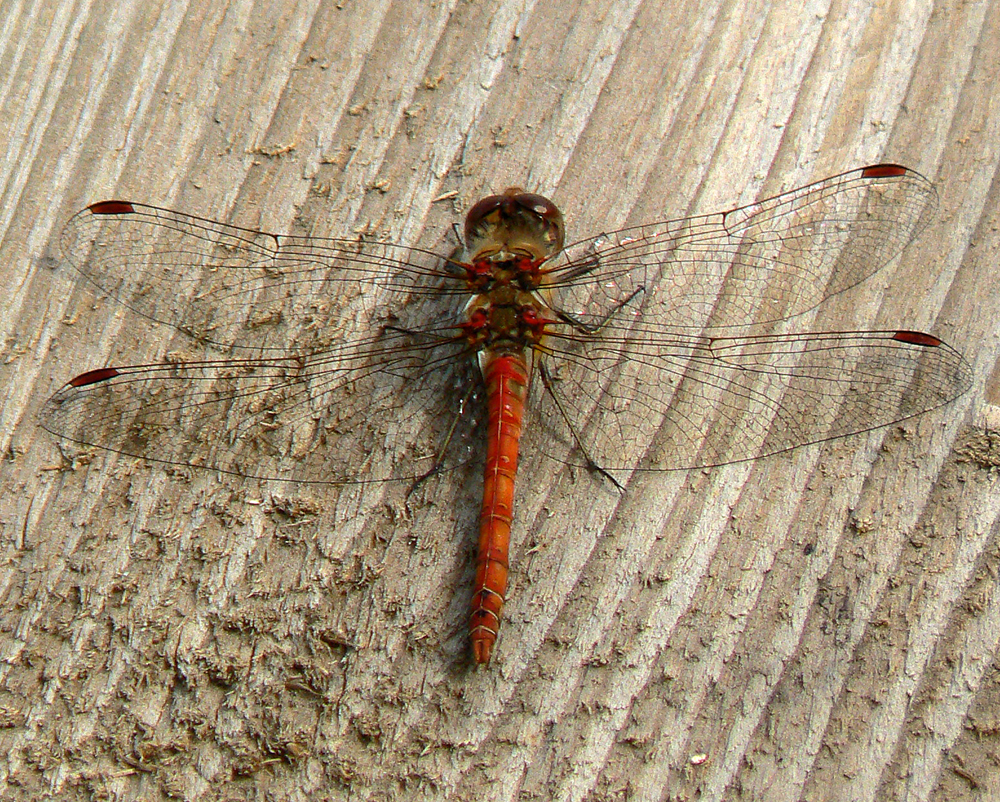
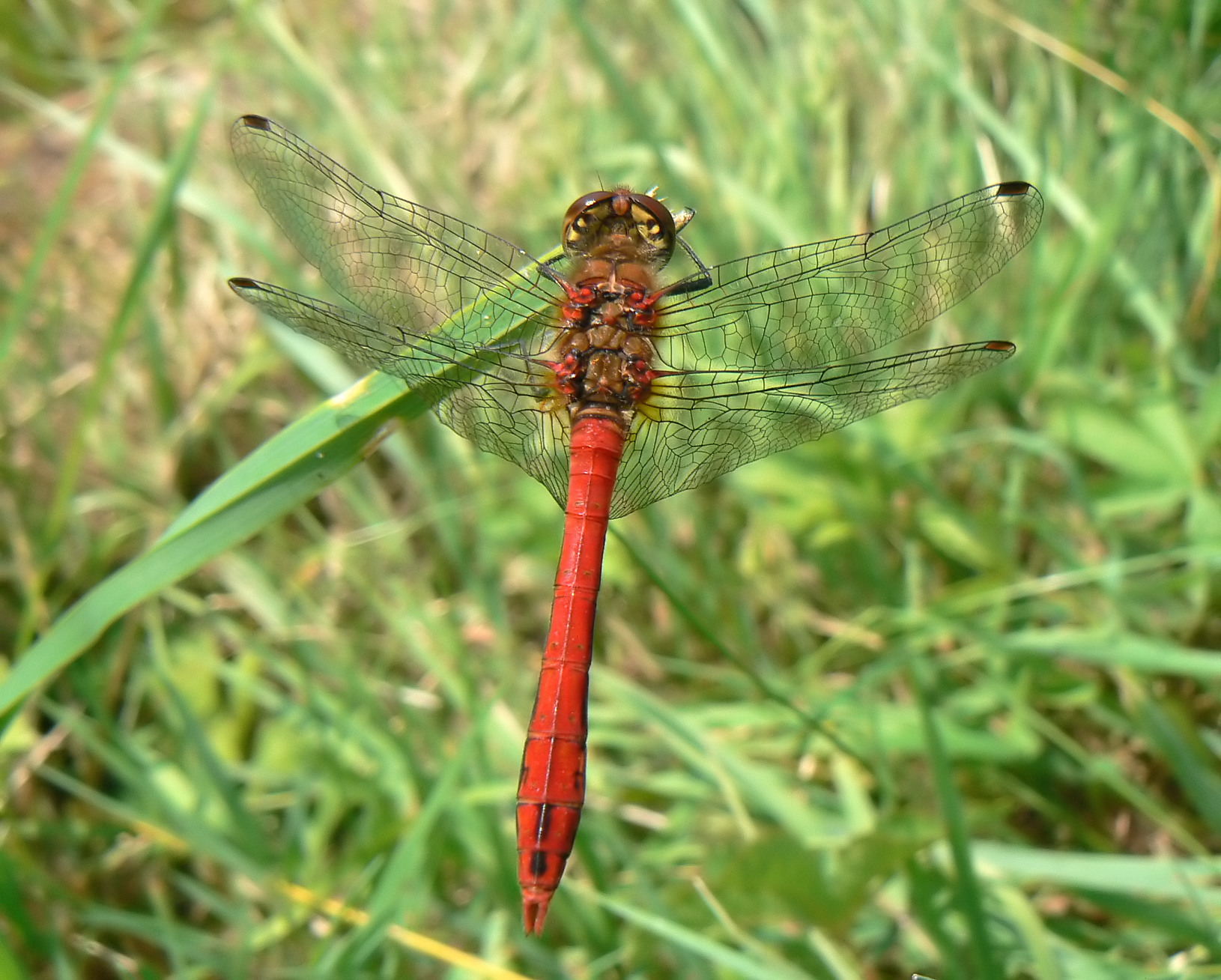
The photographs below compare the Blue-tailed Damselfly with the Red-eye Damselfly.... No explanation necessary as to which is which, and hopefully we may be able to find a Red-eye on the reserve one day.
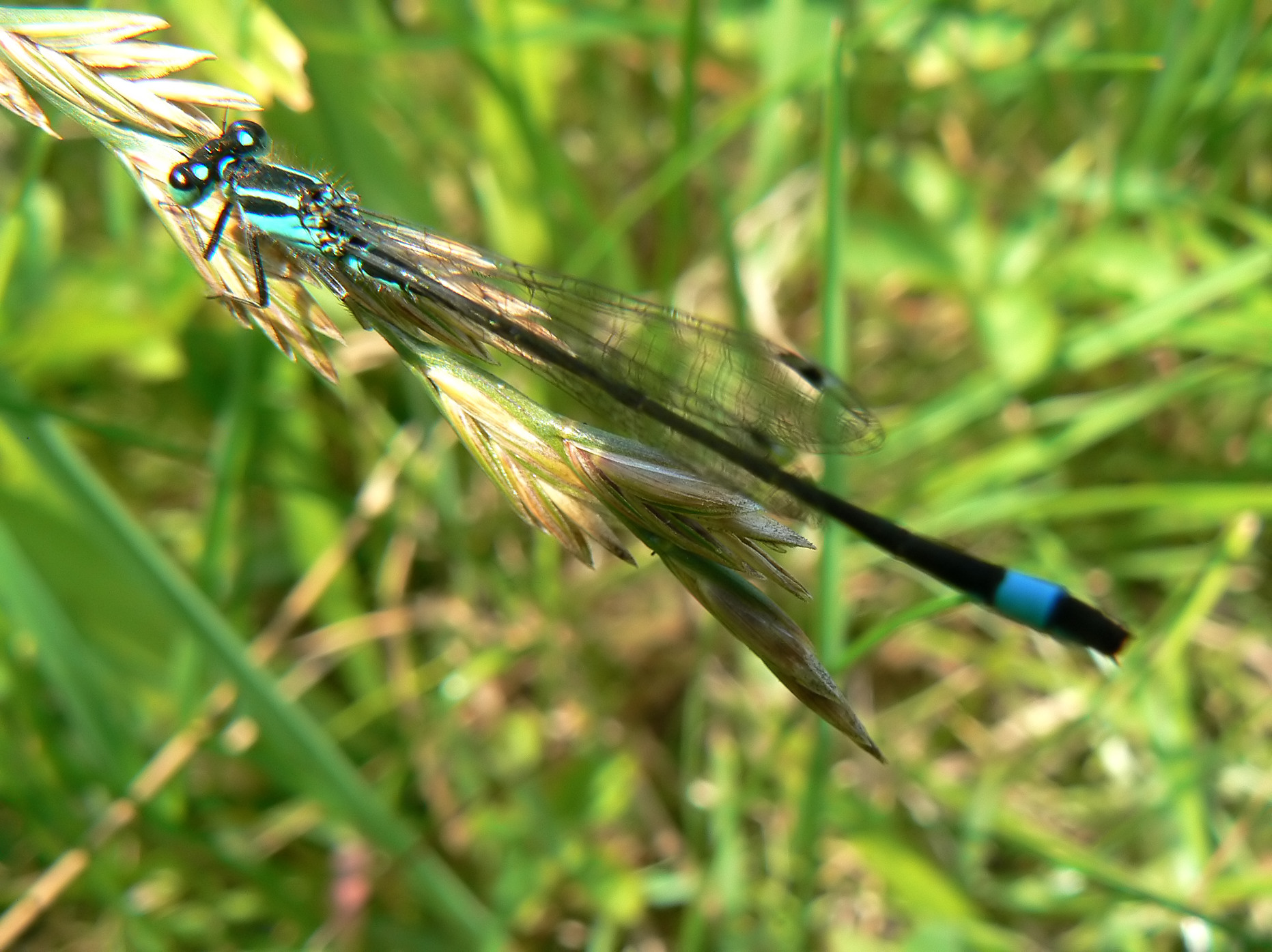
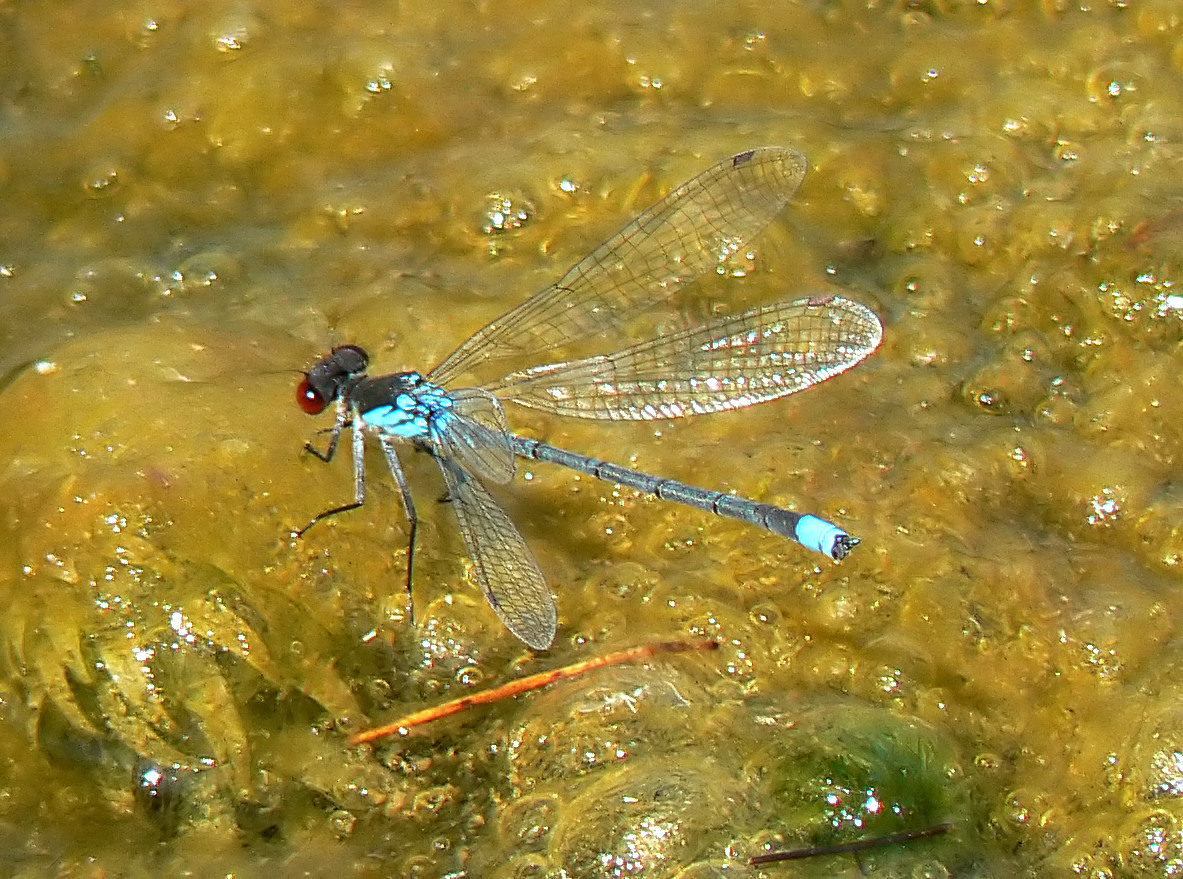
Monday 23rd July - Ray Baker
I saw quite a few things yesterday when over the reserve for the work-party - 2 mice under the reptile 'traps', a large frog which took fright and jumped into the pond, many Great Crested Newts, but the thing that intrigued me most was that there appeared to be at least 2, and possibly 3 different species of large dragonflies down by the pond. Of course, I had neither BINs nor camera with me, and when I managed to clear the decks of duties and return later at about 3:30pm, there were none to be seen.
My curiosity bump had been tickled, so I went down again today and the mystery is at least partially explained..... One of the dragonflies from yesterday was a Brown Hawker - I am familiar with that species and the size and colouration makes it pretty unmistakeable, so that was one out of the 3. The 2nd was a very large male dragonfly which was constantly patrolling the pond area, and seeing off anything else which came within its territory - it was one of those which have a blue body and a greenish head and thorax, which makes a number of Hawker species a possibility, but I was able to get a better look at it today and confirm that it was an Emperor. The males are constantly on the move, seldom settling and then for only a few seconds, so the (poor) photograph below is the best I managed over 90mins of trying. I also spotted a Common Darter - much smaller, but first time I have seen these this year, and also 2 Broad-Bodied Chasers. The third dragonfly remains a bit of a mystery - it was large and greenish and was busy laying eggs on the upper pond - I reckon most likely is probably a female Emperor.
There were also quite a few butterflies about: Meadow Browns remain numerous and I spotted a few Ringlets amongst then, plus quite a few Small Skippers, 2 Red Admirals, a Comma, and the first Gatekeepers of the season for me. There were several Whites seen, and judging by what I have been getting in my garden (where they are a bit easier to identify) these are likely to be Green-veined Whites.
I also had a rake with me today, so used the handle to get an accurate measurement of the depth of water, and I can report that (with the water just lapping close to the underside of the dipping platform) we have 1.35m currently - which is a good deal more than we had this time last year!
Common Darter Emperor
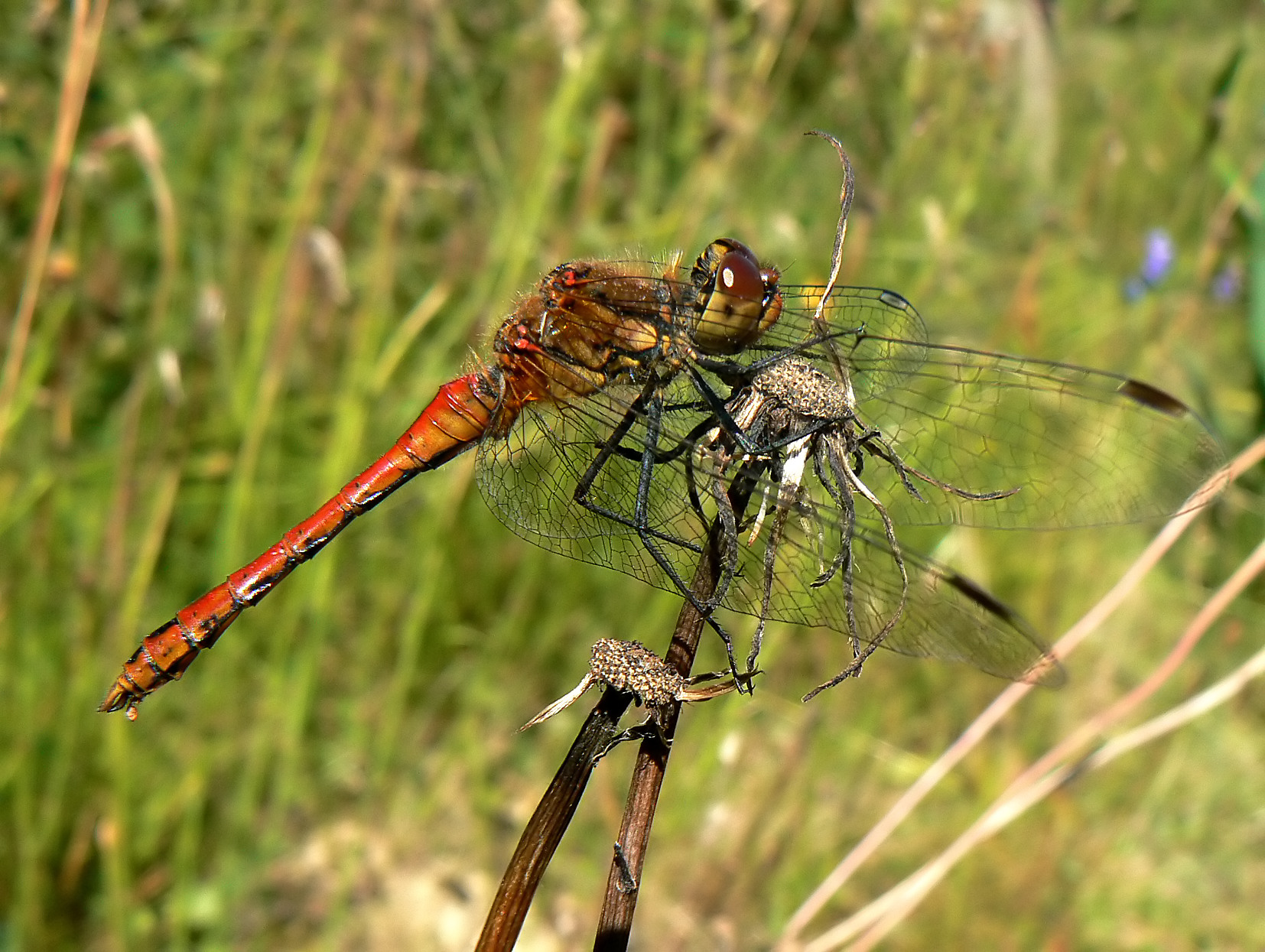
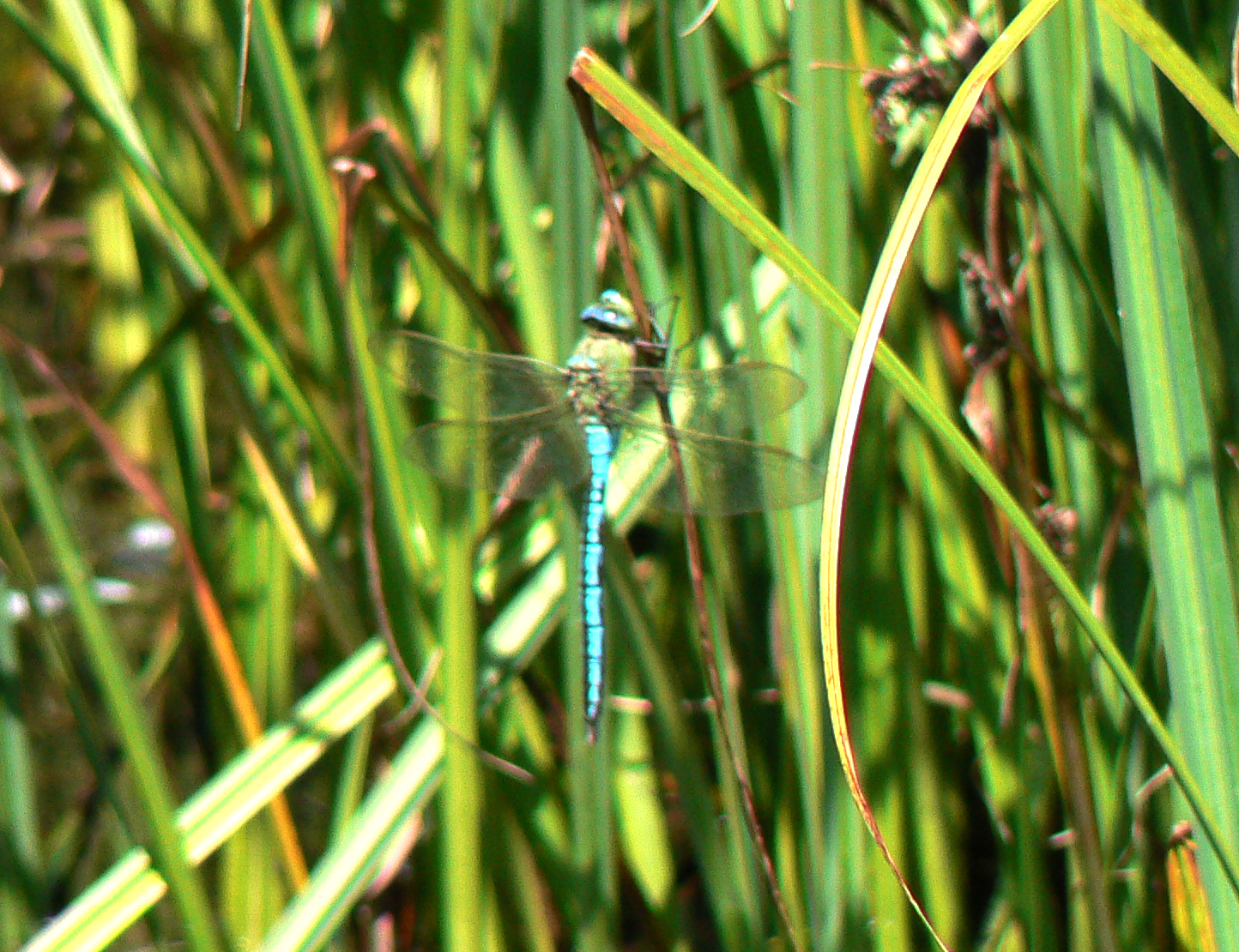
Monday 16th July - Ray Baker
There is an adage that says that in London, you are never more than 10ft away from a rat. As far as I know, this is not passing judgement on the morality of bankers or city traders, but is rather referring to the fact that there are many more rodents around than you might imagine, but that they are good at hiding and therefore you don't always see them. I rather think the same is true of Grass Snakes in the reserve.
Prior to this year, I had only ever had 3 sightings of Grass Snakes - and I'm pretty sure that 2 of them were of the same individual - but in April, we put down some reptile 'traps'.... these are not really traps at all, but just sheets of roofing felt, with the idea that they would provide shelter for snakes etc and also warm up quickly in the sun, which would also help the reptiles. Since then, I have had dozens of sightings, and it is apparent that we seem to have at least 3 different age groups of snakes: adults, quite small youngsters which I'm guessing are probably in their first year, and larger juveniles that are probably in their 2nd year.
I don't think for a minute that our provision of the sheets has actually increased the number of snakes (they've only been down for a few months) but have just created a place where you have a much higher chance of seeing them. What we have also done last summer though, is to create 5 sizable compost heaps in tucked-away areas of the reserve, with the hope that they will be of assistance to the snakes, as they favour the security and warmth of the rotting vegetation as a place to lay their eggs.
If I needed any convincing of the number of Grass Snakes in the area, I received it on Friday, when I was surprised to find one in the flower bed adjacent to my patio. It was a whopper - so big that its tail-tip wasn't in sight at all, which would make it c 1m in length, the biggest I have seen for many a year. Maybe I shouldn't have been quite so shocked, since this area of my garden is where many frogs shelter during the day, and I imagine that's what it was after.
Despite the fact that I have seen lots of Grass Snakes, I have yet to get a satisfactory photograph - they are normally disappearing into the grass by the time I have got my camera sorted - but I will persevere and eventually I hope to get one for the web-site.
Thursday 12th July - Ray Baker
There was a bit of sunshine this morning and it was too good an opportunity to miss - I have learnt that the butterflies etc come out en-masse when there is just the tiniest bit of heat and sun to encourage them, and so it was today.
The meadows are awash with Meadow Browns - they at least don't seem to be suffering from all this cool, wet weather - plus a few Ringlets. Yesterday (didn't have time to write report!) I saw a Small Skipper as well... at least I think it was a Small Skipper, but it was a female and these are virtually identical to another species - the Essex Skipper.... it was one or the other anyway!
Back to today.... The sunshine had brought out some other butterflies too, and I saw 4 Red Admirals (2 in the Wildflower Meadow and 2 more in the Butterfly Garden) and a Comma. Funnily enough, the Surrey Wildlife Trust guy for Hedgecourt was only saying to me last night that he hasn't seen any Commas on his reserve (and they usually get quite a few) so we have beaten him to it!
I did think yesterday, and it was reinforced today, that the best place in the reserve to see butterflies and other insects such as Demoiselles at the moment, is probably the banks of brambles just in 'nightingale corner' of the Wildflower Meadow - they are in flower and get the full sun during the morning, so a good place to look, as is the newly flowering buddleia in the Butterfly Garden.
Any thoughts we may have had about keeping the flora and fauna from the different ponds separate can now be abandoned, since all of the ponds and scrapes have now just become one big single expanse! The clay dipping platform is just starting to go under and we only have about another 10cm clearance before the main wooden platform goes to join it!
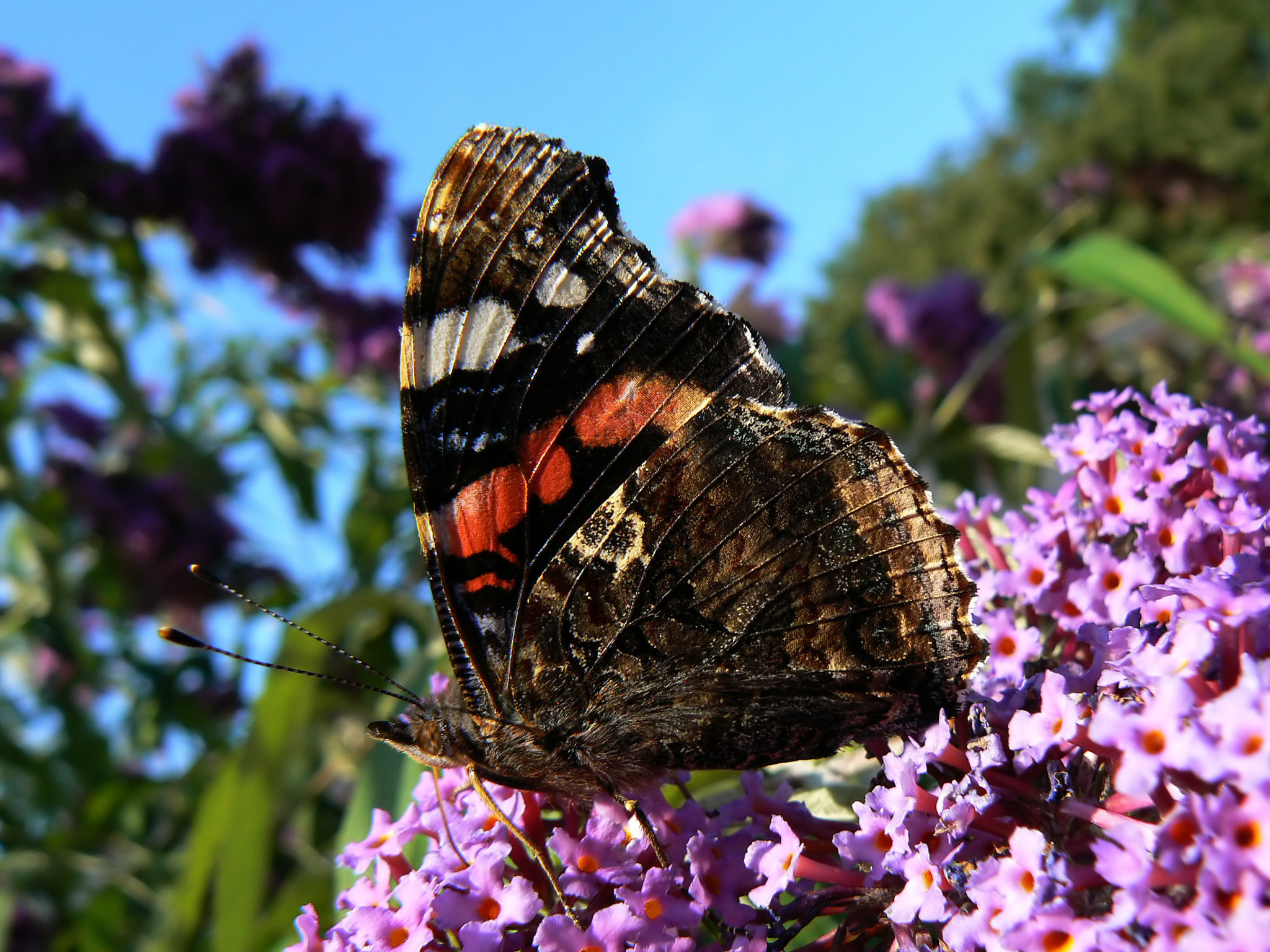
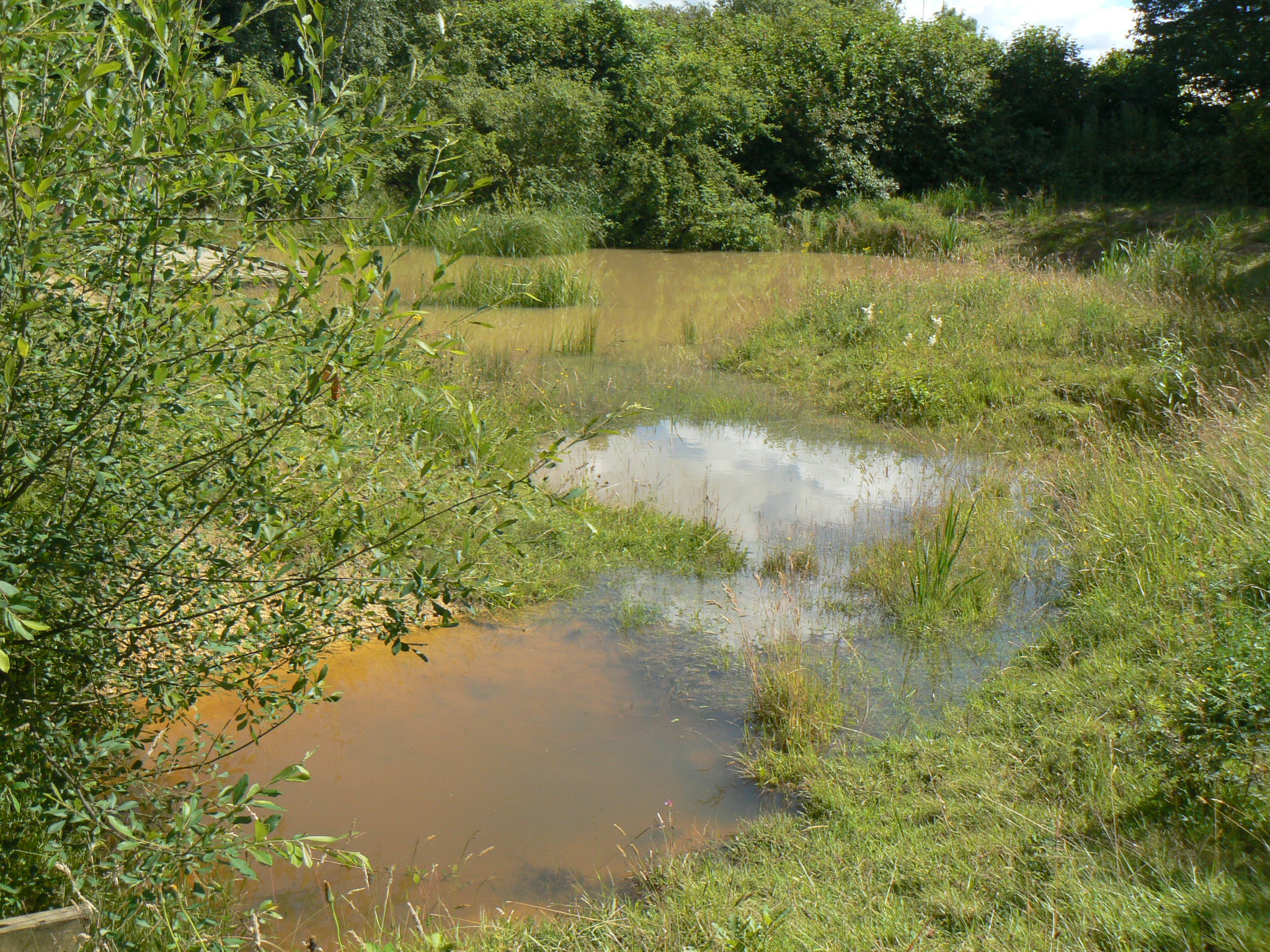
Sunday 8th July - Ray Baker
I had a quick tour round the reserve today in a rare dry interlude in the early afternoon - it was notable how many flying insects were taking advantage of a little bit of heat and sunshine in between the rain squalls. I wasn't really counting butterflies but there were many Meadow Browns on the wing and interspersed with them a few Ringlets... It isn't always easy to tell these 2 species apart when they are flying (easier if they settle, but they don't do that much) and the best field mark between Ringlets and the similar dark, male Meadow Browns is that the former have a white border to their wings which, with practice, you can just about pick out with the naked eye. There were also several Large Skippers and another unidentified skipper that I couldn't get close enough to id.
I also saw some Beautiful Demoiselles in the wildflower meadow and I believe a Banded Demoiselle was just glimpsed as well - we definitely have these in the reserve now as I have seen them on a number of occasions recently
Visiting the pond, we have now established yet another high water-mark - the lower scrape has been engulfed into the main pond again, and the water is lapping around the dipping platform! I saw a large-ish dragonfly which sadly went to settle on top of a tall hedge before I could id it, but I fancy that it was a Four-spotted Chaser, and I also saw several Blue-tailed Damselflys among the more numerous Azures.
There were Grass Snakes under 2 of the mats - which was good, as this was the first time I have seen any in quite a few visits, and I also disturbed a Fox which was enjoying the sunshine and sitting on one of the reptile-mats!
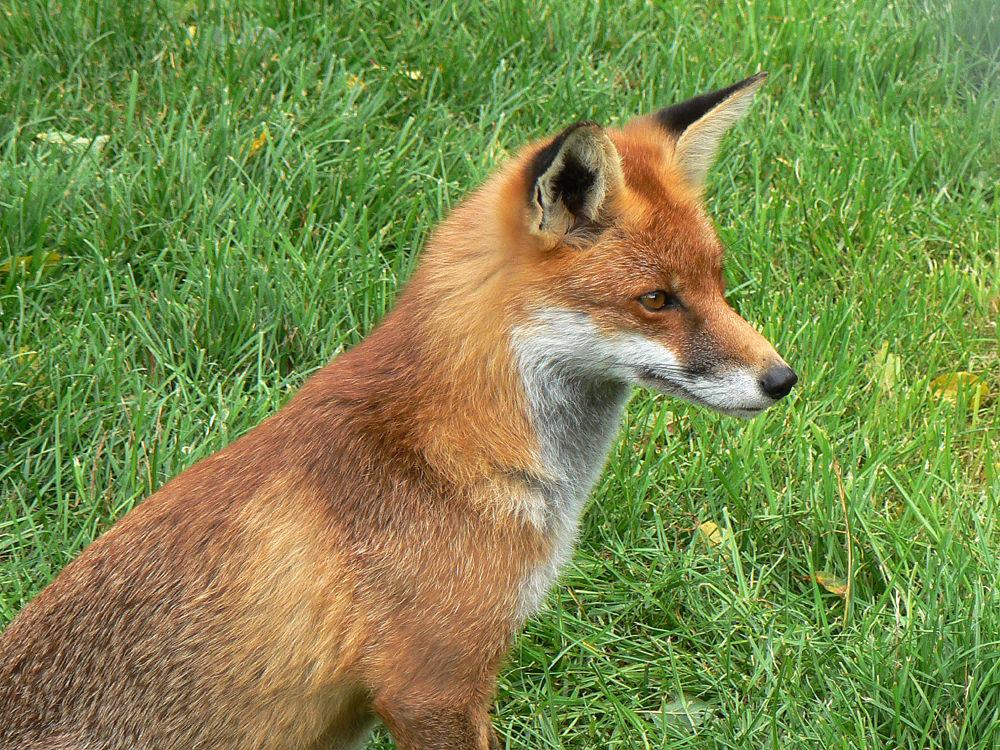

Friday 6th July - John Madden
I walked round the reserves about 5.30 today on what turned out to be a warm dry evening. It was a nice surprise after a changeable day. Two of our reptile monitoring points turned up a total of at least 6 small grass snakes. They are difficult to count as they disappear into the grass. A third point revealed a wood mouse with a newly built nest. I could tell it was new because some of the grass it was constructed from was still green. Wood mice are quite common but like any mammals they are hard to see. This was our first record. They are classic field mice with golden brown upper parts and white contrasting underparts. The smaller house mouse which most people are familiar with are the same colour all over and nowhere near as "smart" looking.
The thistles Ray mentioned a few days ago are marsh thistles. These have grown from seed collected from Cowden Pound Kent Wildlife Trust - a fantastic place for wildflowers if you can find it. It has one of the best populations of Devil's Bit Scabious in Kent. Their pretty blue flowers are a magnet for butterflies and we have managed to establish them in the new ditch. Once again the seed came from Cowden and we probably have several dozen young plants which should be in flower in August.
Another sight in the meadows at the moment are various grasses in flower. Some of my favourites, the bents, have just opened and look like little drifts of brown smoke creating a kind of understorey under the taller yorkshire fog and cocks foot. The flowers are incredibly delicate. They remind me of tiny strands of silk as they open and seem to shimmer.
Wednesday 4th July - Ray Baker
Just popped over to the reserve this morning to have a quick look at the pond - it is all looking very good.... plenty of water and plant-life sprouting all over. The erstwhile bare clay banks are now looking quite green - it is mainly grass coming through first but there are plenty of other more interesting looking little seedlings showing through and it will be interesting to see what they develop into over the next year or two. We did sow quite a bit of seed, so hopefully some of that will show through, as well as just re-growth from the existing seedbank.
There are several clumps of Meadowsweet at various places around the reserve - the attached photograph was taken in the pond enclosure.
It was too wet for there to be much insect life about, but I did disturb an single butterfly, which turned out to be a Ringlet - first of the year on the reserve for me.
A few members of the Planning and Works Committee walked around the reserve last evening, with a view to identifying various works that we will tackle over the autumn/winter period, and there were a couple of notable sightings:- 2 House Martins zooming around overhead in the Coldharbour area (they are a relatively unusual sighting these days) and the huge number of slugs.... the continuing wet weather is obviously much to their liking and they were everywhere - even halfway up trees!
